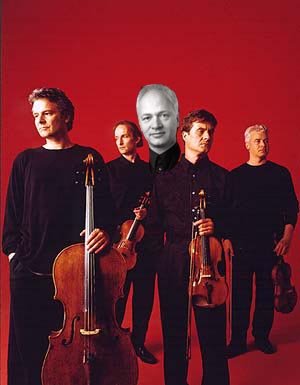 Auryn Quartett with Roger Tapping, with apologies to Manfred Esser (photo credit) |
Why are Mozart's quintets so much more interesting than his admittedly fine string quartets? Scholars have hypothesized that compositionally Mozart worked better in the five-part format, more Baroque (think Lully), than the four-part one of the quartet, more Classical. By electing to have the fifth instrument be a second viola, Mozart frees up the often maligned instrument's melodic potential, because the other viola can take up the considerable role of harmonic filler. Many of the main themes in the Mozart quintets begin in the first violin and are answered not by the second violin but by the first viola. For a composer with a contrapuntal mind like Mozart, that extra voice opens up countless surprising possibilities.
| Auryn Quartett (selected): Grieg Quartets (2001) Braunfels Quartets (1998) Wolf Quartet / Intermezzo (2001) Britten Quartets 2 /3 (1996) |
After intermission, it was what would likely be my favorite Mozart quintet, if forced to answer the question on most days, the G minor, K. 516. I would have expected this sublime work to have been reserved for the final concert, probably paired with its sunnier twin from the same period, K. 515 (both completed in 1787), which is indeed scheduled for the third Sunday. Yet here it was, in the key shared by some of Mozart's most expressive works. The best parts of the first movement are in the development, especially when at one point all of the instruments play the theme in a closely overlapping stretto, and in the dark-hued coda. At these contrapuntal moments, the players' eyes lit up as they translated the form into sound. The Menuetto and its briefly clarified major-key trio, shifted to the second movement, had a well-paced dance character. By the time the somber third movement and the suddenly hopeful G major conclusion struck our ears, the group had long ago hit its stride.
It is a brilliant programming coup to sandwich the Britten quartets with something as universally appealing as the Mozart quintets. These are works that more listeners should know and might take a chance on when packaged like this. The Britten quartets have impressed me deeply, both in the recording by the Belcea Quartet and in live performances by the Jupiter Quartet (no. 2) and the Brodsky Quartet (no. 1). This performance was no different, a combination of intense colors, especially in the tragic, gorgeous slow movement, and vigorous technique, with scherzo-like intensity in the second movement, characterized by short jabs of sound. The only false note was in the memorable opening music, steely chords played very high on the upper three instruments, which never quite sounded effortless. All is forgiven, however, because of the playful opening of the fourth movement, with a very fast, take-no-prisoners conclusion. This is Britten that will make converts.
There were plenty of seats left unoccupied. Do not miss the remaining two performances by the Auryn Quartett -- two Mozart quintets and one Britten quartet on each program -- on the FAES series at Bethesda's Congregation Beth El: March 18 (3 pm) and March 25 (4 pm).
No comments:
Post a Comment